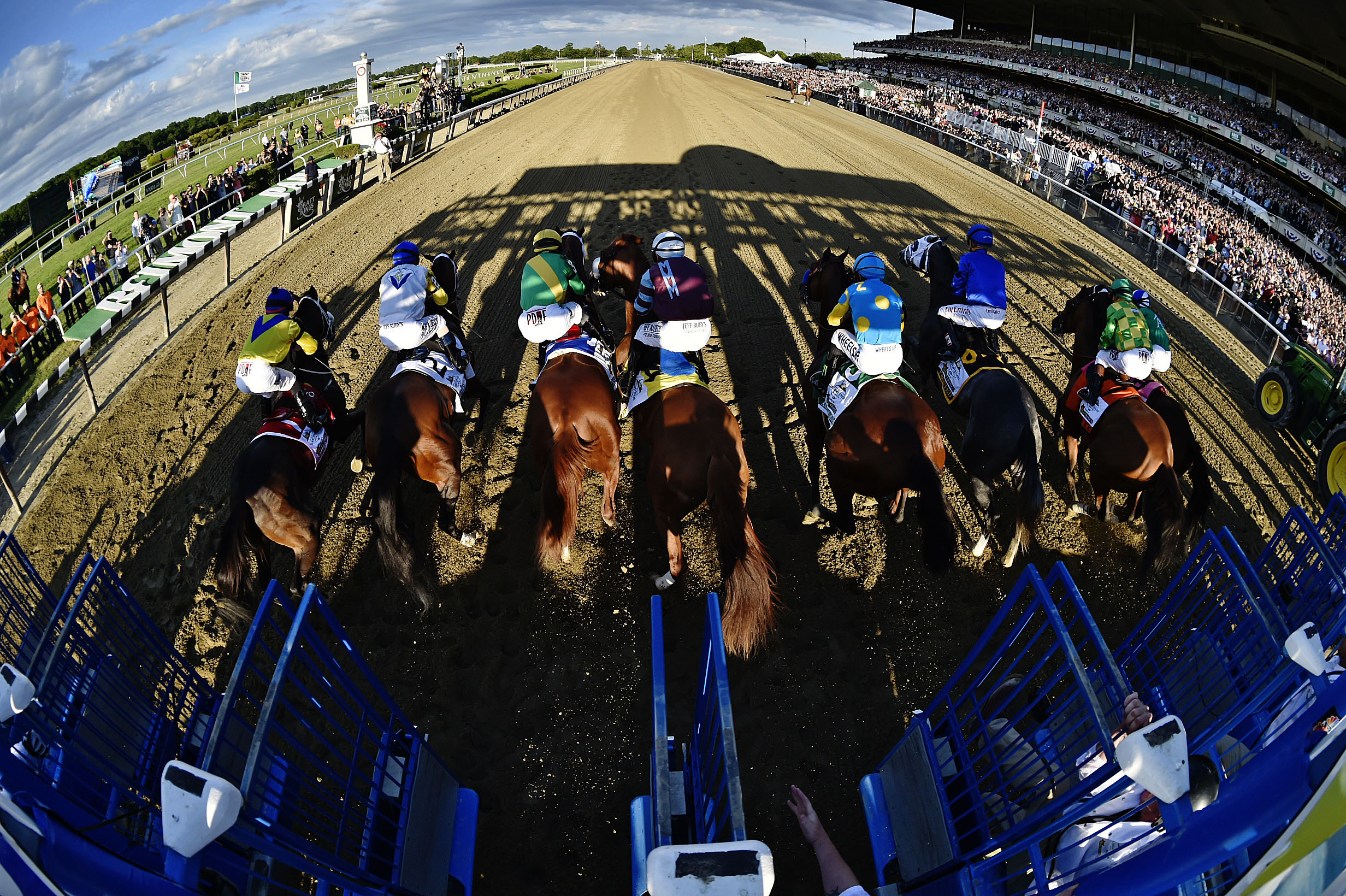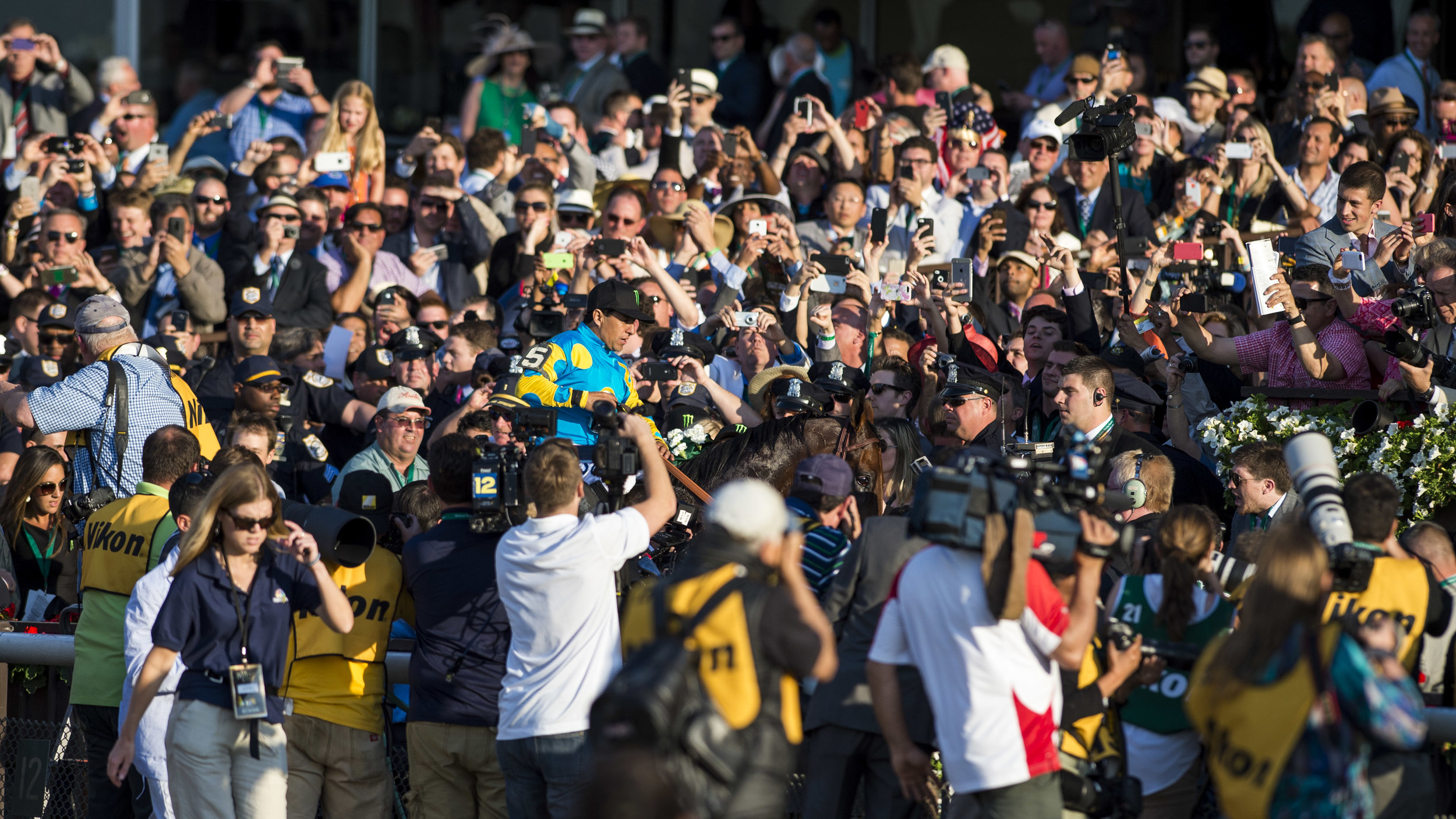In the winner's circle at Belmont Park with friend and colleague Andy Hancock before the 147th running of the Belmont Stakes. Photo by JC Carey.
I have a confession. I have never enjoyed horse racing.
I’m not a fan of large crowds, and have never been particularly fond of horses. While I recognize their strength and beauty from a distance, I don’t choose to be close to them. Their faces are too big, legs too strong, hooves too heavy. I don’t trust them, and they know it.
With that said, I feel incredibly lucky to have spent as much time covering horse racing as I have. It’s a strange and seemingly outdated sport, but it brings masses of people together and is an incredible spectacle when you have the chance to be a part of it.
There is one race in particular that will be forever burned into my - and the many other’s - memory. The 2015 Belmont Stakes.
Three years ago - almost to the day - I was standing in several inches of mud, surviving on little sleep and several donuts (compliments of the Nikon Professional Services staff), wiring remote cameras on a rainy Saturday morning at Belmont Park in Elmont, NY, to setup up for - what I hoped - would be an historic day.
Later that afternoon, American Pharoah and seven other thoroughbred race horses would run Belmont’s 1.5-mile track under a beautiful, sunny sky to the chorus of 90,000 fans hoping the 37-year Triple Crown drought would finally, mercifully end. No horse had taken the crown since before I was born (Affirmed in 1978 was the last winner).
Thirty seven years of anticipation and disappointment were all resting on the shoulders of one 3-year-old colt and the jockey (Victor Espinoza) who would lead him.
I had been in that exact position before.
My first Triple Crown chance was in 2008 when Big Brown barely crossed the finish line in dead last after giving up along the final stretch.
The second was in 2012 when I’ll Have Another was retired on the eve of the Belmont Stakes due to a tendon injury.
I didn’t even go to the 2014 Belmont Stakes when California Chrome had a chance at history. I just assumed he would lose. He did, finishing 4th in the 146th running of the race.
But then 2015 rolled around with another chance at the elusive Triple Crown, and it somehow felt different.
American Pharoah had won the previous two jewels of the Triple Crown - the Kentucky Derby and the Preakness Stakes - in dominating fashion. He appeared healthy and unfazed by the fast turnaround and travel.
It was agreed by everyone who knew anything about horse racing that American Pharoah was the sport’s best chance to win the crown in nearly four decades.
I was hopeful this would be the year and traveled to New York to cover the race with Sports Illustrated.
I wanted to approach the race differently. I knew there would be a slew of photographers taking pictures head-on from the finish line to capture history the moment it happened. I wanted something different.
Once I finished wiring cameras under the track's rail I went up to the second level of the stands to find my spot. I wanted to silhouette the fans in the grandstand against the horses on the track to (hopefully) show the excitement at the park.
I found where I wanted to be between the 16th pole and finish line on an apple crate behind the last row of seats. I talked to an usher to make sure he knew I’d be there at race time, checked off with broadcast, and waited.
My only concern with the spot was that I would get blocked. I’m not very tall, and the apple crate wasn’t either. If the crowd was on their feet - as I assumed they would be - I might not be able to see anything through my 600mm lens. To give myself a little insurance, I put a 70-200mm lens on a Nikon D5 and attached it to a pole a couple feet above my head.
When race time finally rolled around, the anticipation was palpable. The stands seemed to vibrate with excitement.
As soon as the starting gate opened, so did the crowd. The entire grandstand shook as fans watched American Pharoah stumble before taking the lead. I have never and don’t think I ever will again hear a crowd as loud as the crowd at Belmont Park that day.
The horses were out of sight almost as quickly as the race started, covering a quarter mile in 24 seconds, and disappearing to the backside of the track.
I heard fans desperately exclaim that American Pharoah was losing ground, while others excitedly observed that he was winning. No one was sitting. To my dismay, many were standing on their seats, completely blocking my view.
As the horses approached the final turn the cheers grew into a roar as American Pharoah hit the final stretch still in the lead. I stood on my tip toes and raised the 600mm to my face, my line of sight mostly blocked, hoping that the remote above me was firing.
I shot continuously, tracking the horse as best as I could through the swarm of fans cheering louder by the second. What started as a deafening cheer had turned seismic as American Pharoah pulled even further away from the rest of the field securing his place in history.
The wait was over. Racing finally had a champion.
I remember quickly breaking down my cameras to get back to the media room to transmit. I nervously checked the 70-200mm remote and was relieved to see that it had worked just as I hoped it would - fans silhouette against the track as American Pharoah dashed towards the finish line.
I jostled my way through the dense crowd trying not to trip, drop a camera, or get crushed in the melee. All around me fans were hugging, high-fiving, and crying. The years of disappointment were over.
I admit I felt it, too. Together 90,000 people had witnessed sport’s longest drought come to an end. The release was cathartic.
This year brings another chance for a Triple Crown with Justify and jockey Mike Smith.
I’m not in New York for this one. Instead of wiring cameras on a soggy track, I’ll be floating on the Ortega River with a few friends and some sunshine.
By race time I’ll be preparing dinner with the TV on, watching closely to spot friends and colleagues along the race track, hoping for good weather, and another spot in history.






























